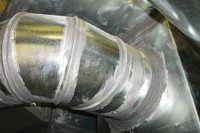Project estimation is a crucial element of the duct-cleaning process.
Whether the ducts being cleaned are in a massive office building or the home of a family of four, the parameters of the project must be clearly established before the work begins.
“It’s critical,” says Tom Yacobellis, co-founder and director of operations at Ductz. “I couldn’t imagine doing a project without strict project estimating. Project estimation links directly to production schedules, if done correctly.”
As critical as the project estimation is, there isn’t simply one way to do it, and methods vary by company or personal preference. Yacobellis’ organization uses a specific method that allows them to come up with an accurate projection as to how much the project will cost. However, they also tailor the estimate to the customer.
Yacobellis’ organization applies a different approach to each type of unit, allowing them to come up with the most thoroughly transparent method to accounting for the cost of each specific task associated with the project.
“We look at the components in three different ways,” Yacobellis says. “Some of the components, like ductwork, are done by the linear footage in a computer. Some of the components like the units are done by the man hours applied to the unit. The third one is based on the internal square footage of the component.”
For example, if the inside of a duct system needs to be coated, the internal square footage is calculated so that the technician can apply the product in the correct quantities.
Clarity
Not only does estimation link directly to the production schedule, but it allows the direct parameters of the operation to be set, putting both parties at ease that they’re in agreement on the job that was contracted to be done.
“It creates an absolute known quantity for what you’re doing,” says Yacobellis. “Customers cannot add units to the project without knowledge of the cleaner. The clarity of the project is absolute; no ambiguity. If something is missing they have to say it before the project starts.”
One of the most common mistakes made during the process of project estimation is customer confusion about what aspects of the project are included or excluded from the cost or scope of work. A clear, accurate estimate can create fairness on the open market.
“There’s a sense of accuracy that very few people can provide, and it gives them a feeling of confidence going into the bid,” Yacobellis says. “We detail the system so thoroughly that a building owner often removes the values and sends our proposal to a competitor, telling them ‘this is our exact system’ and asking them if they could match the service at the same cost.”
The National Air Duct Cleaners Association standard also takes into account the best interests of residential customers. Since a degree of not-necessarily common knowledge is required to understand whether your ducts need to be cleaned, NADCA attempts to make sure no customer pays for a job he or she doesn’t need.
“Theoretically, when you do a residential job, one of the first things your workers have to do is determine whether or not the ducts need to be cleaned, even if the customers asked for it,” says Yacobellis. “That’s the NADCA standard.”
What works
Residential and commercial HVAC construction projects differ in other ways as well.
“Residential projects use a variety of different methodologies,” says Yacobellis. “For example, some people will price a system by the number of registers. Some people will do it by the square footage of the house. Some people will do it with the ductwork alone and have a secondary add-on for the units.”
More variables exist when it comes to assessments. Most residential and smaller assessments are done for free, unlike assessments on bigger projects.
“Massive projects require on-site assessments for sometimes days, and then calculating what needs to be done,” says Yacobellis. “The price can go up to $5,000 for complete assessments to find out how much ductwork is there, if the blueprints are available, the type of ductwork and the event. The assessment is required by NADCA standards. The assessment is the preliminary step to estimation on the commercial side.”
Though there are many variables, the process of project estimation remains a crucial one to a successful undertaking for duct cleaners. Though it can be daunting, it assures the correct job is done, the customer is happy and everyone breathes clean air.
This column was supplied by the National Air Duct Cleaners Association. Contact the group at www.nadca.com.









